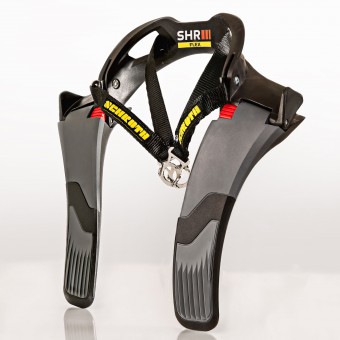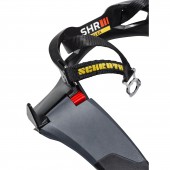SHR Flex Frontal Head Restraint by SCHROTH Racing |
Home > Winners > #49037 |
 |
|
||||
| DESIGN DETAILS | |||||
| DESIGN NAME: SHR Flex PRIMARY FUNCTION: Frontal Head Restraint INSPIRATION: Deficiencies in the 20-year-old design direction of established Frontal Head Restraints has limited their market acceptance. This is why upper neck injuries remain the single largest cause of racing fatalities. Initial ideation identified a novel product development opportunity to address these preventable racing deaths. It inspired the detailed design of the SHR Flex - one which overcomes market-limiting problems of existing products and meets rigorous biomechanical performance demands. UNIQUE PROPERTIES / PROJECT DESCRIPTION: SHR Flex protects racecar competitors from severe or fatal upper neck injuries in high-impact crashes. Ordinarily it is unobtrusive, does not limit racers helmet motions, and automatically adapts to any body type and seating configuration. In an impact its unique articulated low profile design uses kinematics to activate into a biomechanical optimized restraint configuration. Integrated into a body contouring foundation, it provides racers an unprecedented combination of safety, comfort and fit. OPERATION / FLOW / INTERACTION: The SHR Flex's "collar" is tethered to its user's helmet and sits around their neck, with its "legs" resting and restrained on their chest under the shoulder straps of their seatbelt system. In an impact the exaggerated kinematics of the racer's helmet motions causes the collar to pivot upwards to control the rate and magnitude of loads on the racer's upper neck. The dynamic articulation and flexible legs combination provides a unique and unprecedented low profile and comfortable design. PROJECT DURATION AND LOCATION: In 2013 SCHROTH Racing established design parameters and made initial prototypes in Arnsberg, Germany. Evaluations using crash test dummies at test facilities in Auburn Hills, Michigan followed. Creature and Enginuity Works in Atlanta, Georgia were then commissioned to create the detailed design that became the SHR Flex. In late 2015 production started in Germany, third-party biomechanical acceptance testing was completed in Indianapolis, Indiana, and the SHR Flex launched. |
PRODUCTION / REALIZATION TECHNOLOGY: Initial ideation identified a preferred design direction which introduced two innovations - a rigid articulating "collar" to manage impact energies, and torso-conforming, flexible, overmolded "legs" to comfortably and reliably anchor the device during an impact. Being total breaks from established approaches, both inventions required extensive modeling for function, form and material properties, with final acceptance criteria established with user trials and high-impact crash test sled testing. SPECIFICATIONS / TECHNICAL PROPERTIES: SHR Flex meets the biomechanical and technical performance requirements of the SFI Foundation, Inc.'s Specification 38.1. To accommodate all racers it is offered in Medium 300 x 330 x 70 and Large 320 x 330 x 70 (mm W x L x H). Both weigh 0.9 kg. They are value-priced and sold through multiple distribution channels. Each comes with patent pending "Twist Anchor" helmet latches that allow a racer to quickly, simply, blind, and single handed latch/unlatch it with their helmet. TAGS: Frontal Head Restraint, FHR, Head and Neck System, SFI Foundation, SFI 38.1, SCHROTH Racing RESEARCH ABSTRACT: As well as human factors engineering, detailed evaluations were conducted against SFI Foundation acceptance criteria using crash dummies providing 80 channels of biometric data on a servo-controlled crash sled. Variable geometry prototypes were used in an iterative process to identify biomechanically optimal configurations and constructions. The breakthroughs of dynamic collar and body conforming legs has elevated performance in an area of design that had been stagnant for over than 20 years. CHALLENGE: To achieve the desired market penetration needed to advance racer safety, the brief required the SHR Flex design to optimize weight, enhance racer comfort, simplify selection and use, achieve a low-profile that would not interfere with a racer's normal head motions, and be value engineered to control cost. Further, it needed to demonstrate repeatable robust biomechanical performance during multiple 70g deceleration impact simulations of a 1,500 kg racecar hitting a concrete wall. ADDED DATE: 2016-06-21 00:11:24 TEAM MEMBERS (3) : Creature Product Development, Enginuity Works Corp. and SCHROTH Safety Products GmbH IMAGE CREDITS: SCHROTH Racing, 2016. PATENTS/COPYRIGHTS: U.S. and International Patents Pending. U.S. No. 2016/0158630 "Head and neck restraint device with dynamic articulation" and U.S. No. 2016/0143402 "Locking clip and anchor assembly for a tether." |
||||
| Visit the following page to learn more: http://goo.gl/rNTWUK | |||||
| AWARD DETAILS | |
 |
Shr Flex Frontal Head Restraint by Schroth Racing is Winner in Sporting Goods, Fitness and Recreation Equipment Design Category, 2016 - 2017.· Read the interview with designer SCHROTH Racing for design SHR Flex here.· Press Members: Login or Register to request an exclusive interview with SCHROTH Racing. · Click here to register inorder to view the profile and other works by SCHROTH Racing. |
| SOCIAL |
| + Add to Likes / Favorites | Send to My Email | Comment | Testimonials | View Press-Release | Press Kit |
Did you like Schroth Racing's Sporting Goods Design?
You will most likely enjoy other award winning sporting goods design as well.
Click here to view more Award Winning Sporting Goods Design.








